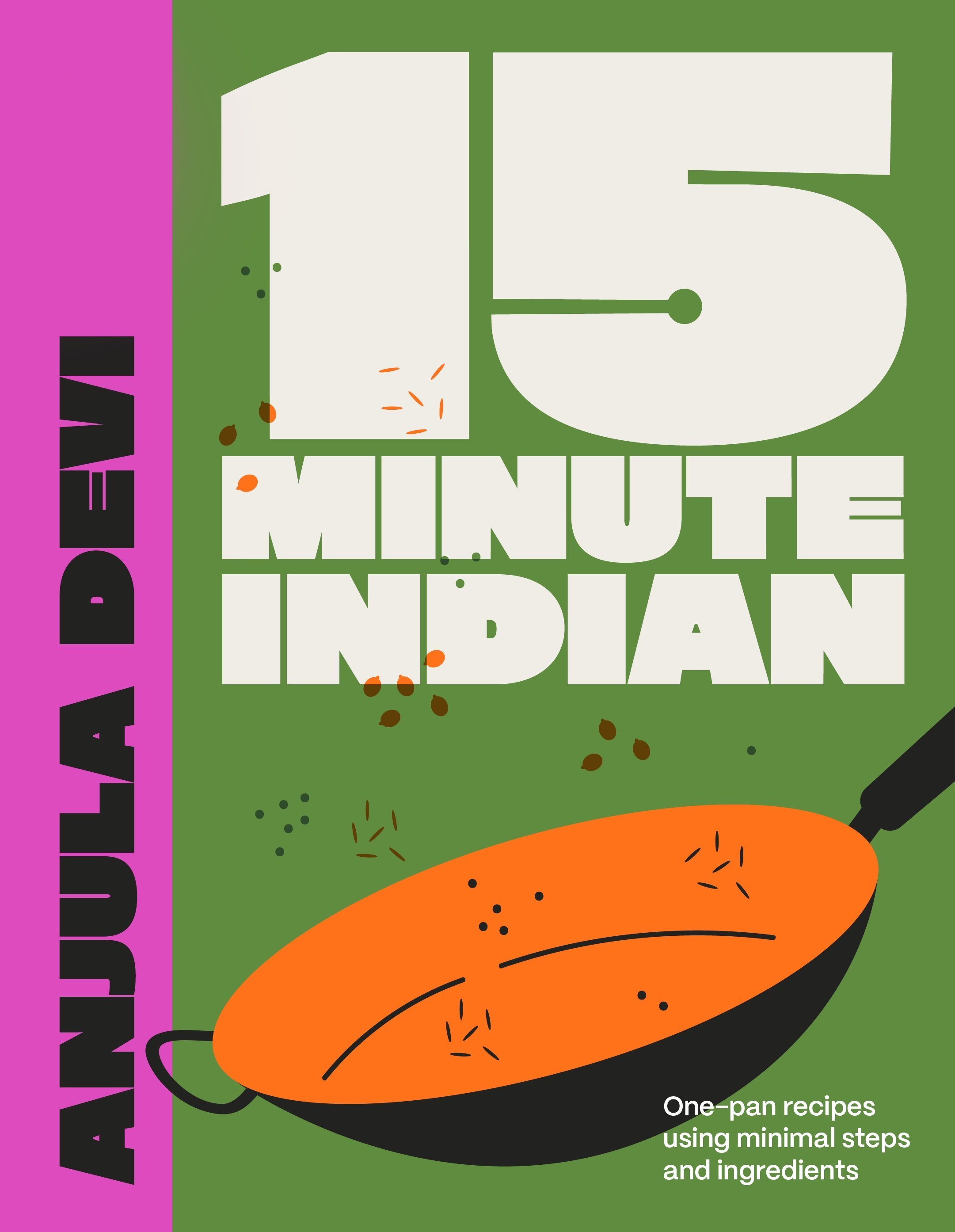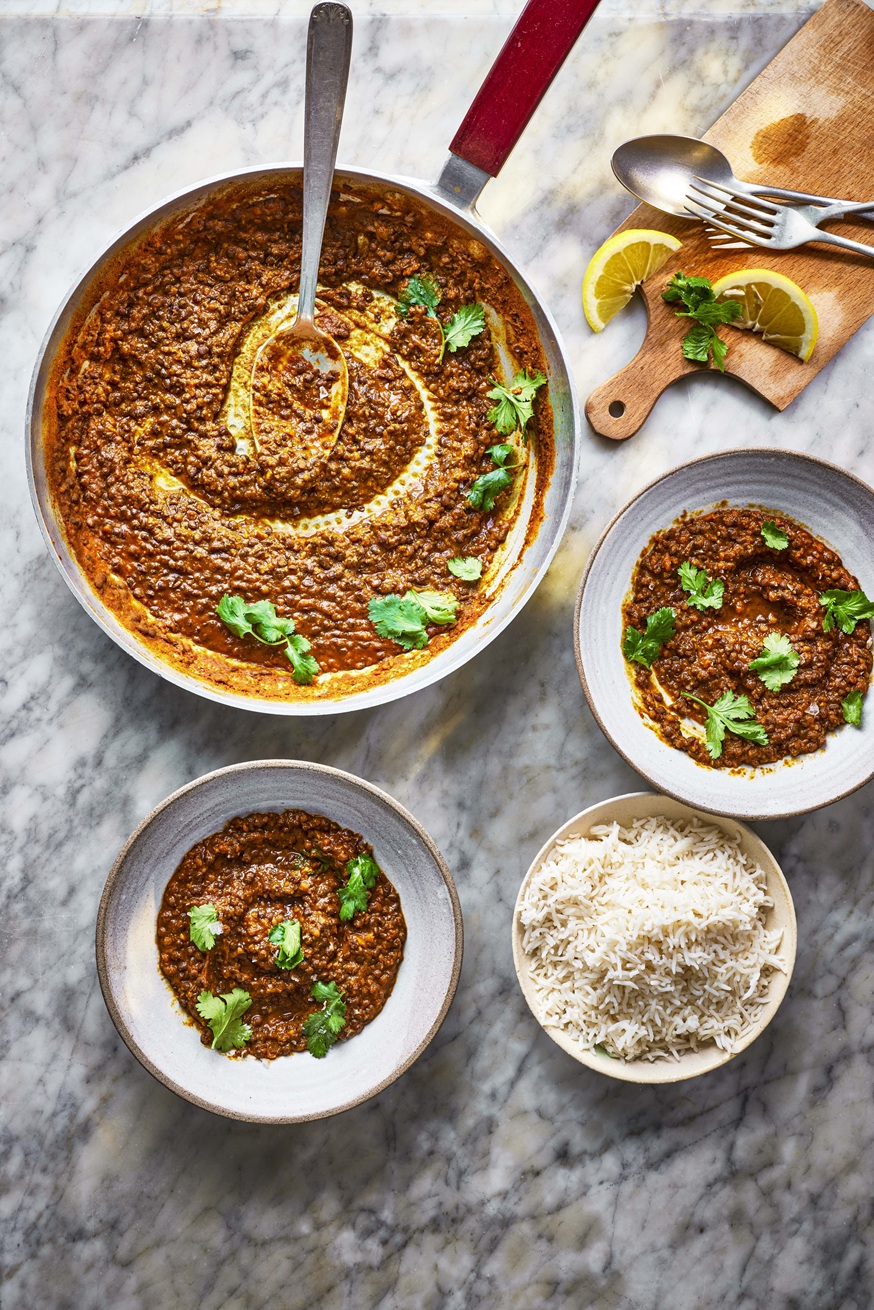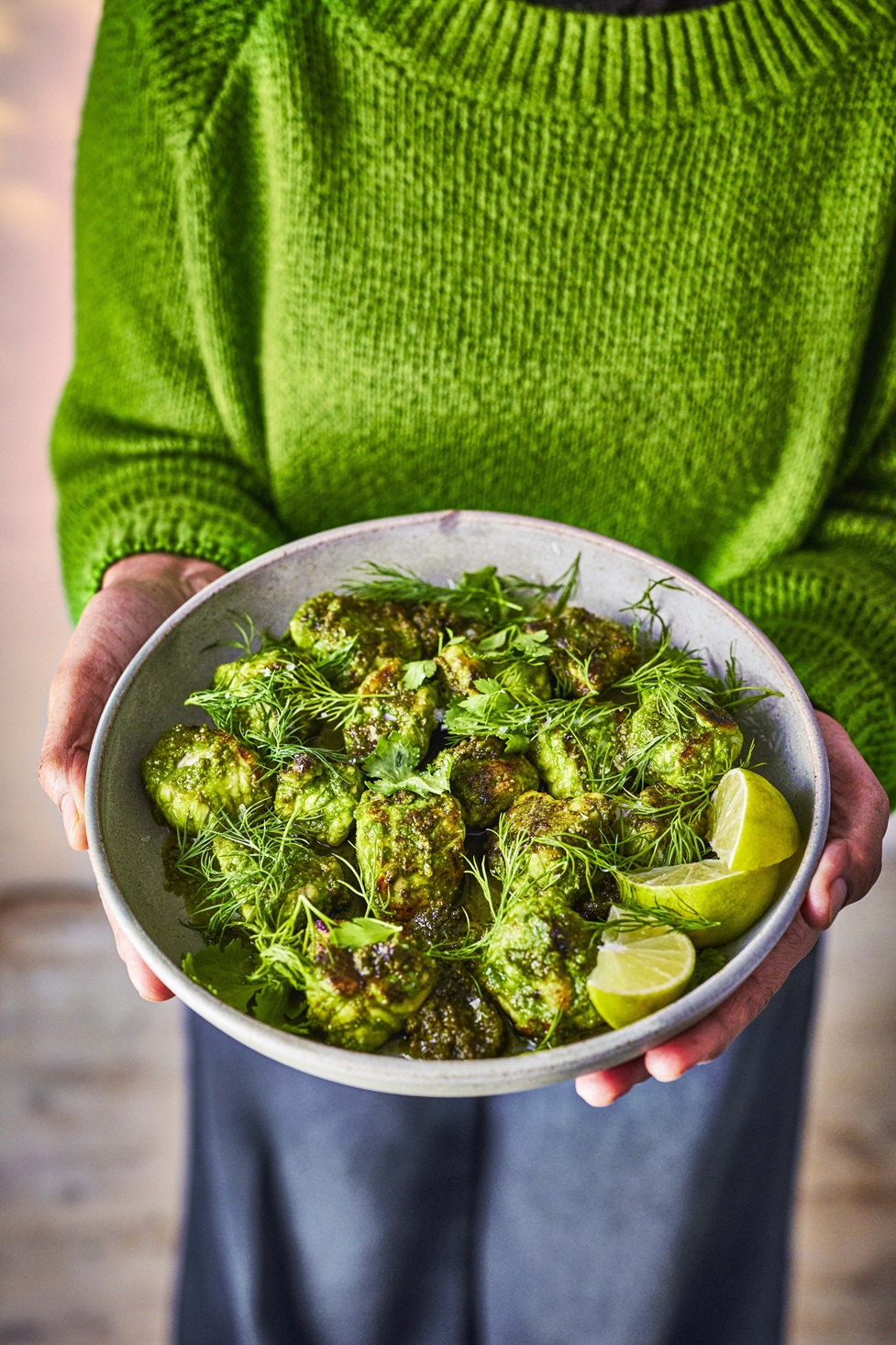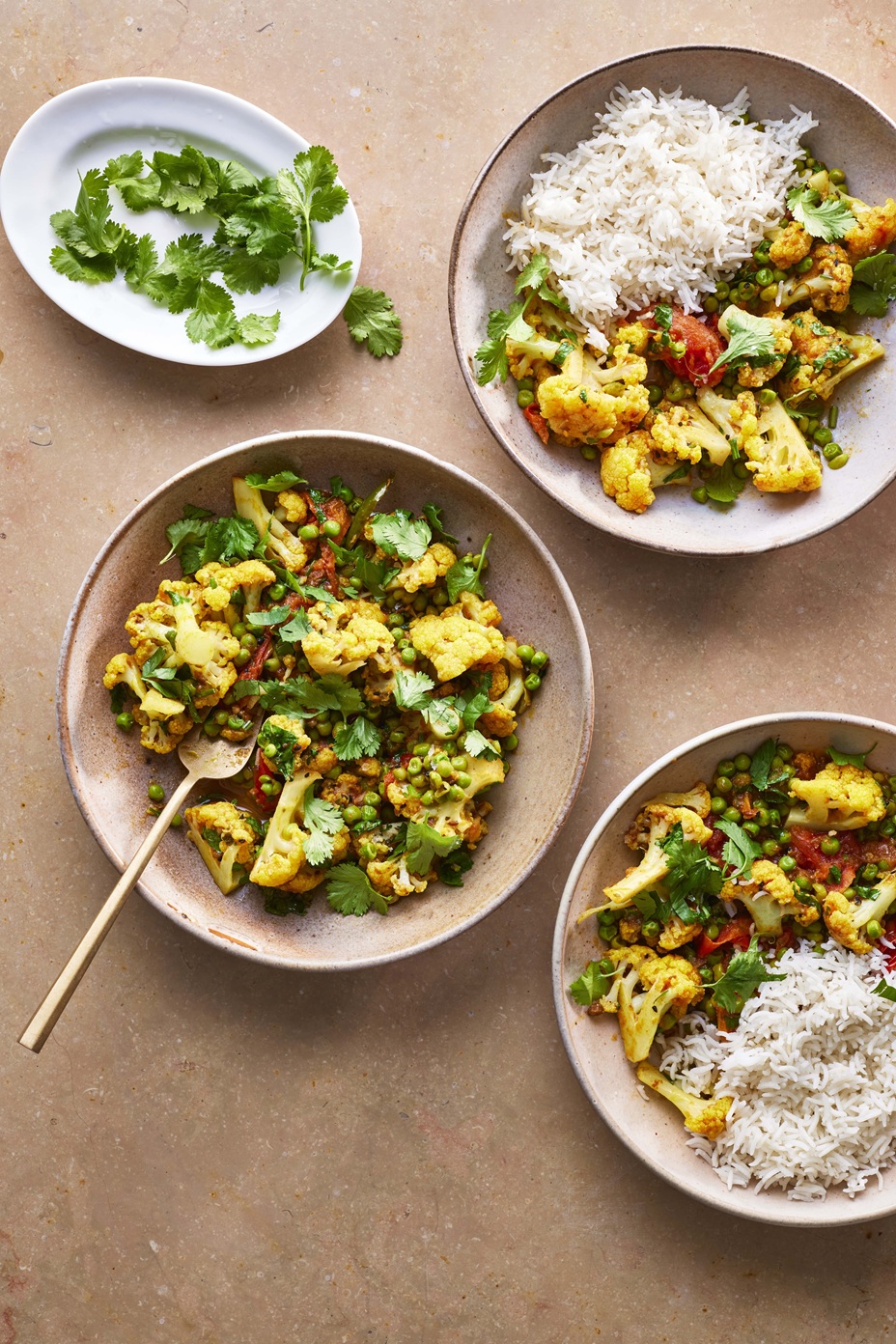
Having put on almost 14kg, her blood pressure was spiralling out of control. It was the catalyst for her to perfect the technique for quick Indian food.
"Now I wanted the dishes to be generally lighter and less carb dense as well as fast."
Devi does not want to take away from the slower and more traditional way of Indian eating and cooking where multiple dishes are served as a spread. She wants to promote the idea that it is OK to create one dish to enjoy on its own.
"I wanted something valuable and inspiring for weekday cooking. If you do have time, I love that you can choose to pair so many of these dishes together."
It is also OK to serve the dish with a bowl of leafy green salad instead of rice or roti, she says.
The key to fresher, lighter dishes in less time is Devi’s one-pot method where she ensures everything is cut up small, added to the pan or wok in a particular order with some hot kettle water and usually ghee or oil, then cooked medium-high for a set number of minutes.

"You’ll know if it is ready by the aromas. Your pan or wok will also be a good indicator, as generally it will become dry around the sides."
Before she developed this approach Devi followed the traditional way of cooking Indian food learned at the feet of her father growing up in West London in the 1970s.
"I loved pounding the spices that Dad had carefully selected. In effect he imparted a life skill, which has served me incredibly well."
In her latest book 15-Minute Indian she also includes some tips on the main spices she uses, as well as chapters on chutneys and pickles and Masalas and make-aheads. There is also a "feasts" section if you want to make a spread, such as these below, part of her "The Simple Life" feast of six dishes which serve 8-10 people.
The book
Recipes extracted from 15-Minute Indian by Anjula Devi. Published by Quarto. RRP $55.
 Beluga lentils
Beluga lentils

I just love how readily beluga lentils absorb all the spices. This recipe is like a hug in a bowl.
Serves 4
Ingredients
2 x 400g tins beluga lentils
Large handful of fresh coriander (cilantro)
2 Tbsp ghee or oil
1 tsp cumin seeds
1 tsp ground turmeric
Chilli powder, to taste
2 tsp garlic paste
1 tsp ginger paste
2 Tbsp tomato paste
1 tsp ground cumin
1 tsp ground coriander
Fine sea salt, to taste
Juice of 1 small lemon
Serve with
Aromatic courgette rice (see below) or plain boiled rice (optional)
Method
Fill and boil the kettle.
Drain and rinse the beluga lentils.
Chop the fresh coriander and set aside.
Place the wok on a high heat, then add the following ingredients in this order: 700ml (3 cups) hot kettle water, ghee or oil, cumin seeds, beluga lentils, turmeric, chilli powder, garlic paste, ginger paste and tomato paste. Place the lid on the wok and reduce the heat to medium. Cook for 10 minutes.
Remove the lid and reduce the heat so that the mixture is simmering. Add the ground cumin and coriander and salt to taste.
Simmer for 3 minutes. While it is simmering, gently mash the lentils a little with a potato masher for a creamier texture.
Switch off the heat, then add the fresh coriander and lemon juice. Stir and enjoy.
Aromatic courgette rice
Combining vegetables with rice was a way that my dad found to sneak vegetables into our diet. I grew up in an age when we simply went hungry if we didn’t eat what was put in front of us.
Serves 4
Ingredients
270g (1½ cups) basmati rice
1 large courgette (zucchini)
2 Tbsp coconut cream
2 Tbsp ghee or oil
6 green cardamoms, slightly bashed
2 tsp cumin seeds
4 cloves
1cm piece of cinnamon stick
2 tsp garlic paste
1 Tbsp white wine vinegar
1 tsp ground turmeric
Chilli powder, to taste
2 Tbsp tomato paste
8-10 cherry tomatoes
1 tsp ground black pepper
Fine sea salt, to taste
Large handful of fresh dill
Method
Fill and boil the kettle.
Give the rice a quick rinse.
Dice the courgette into small pieces.
Place a wok on a high heat, then add the following ingredients in this order: 750ml (3Πcups) hot kettle water, coconut cream, ghee or oil, green cardamom pods, cumin seeds, cloves, cinnamon stick, garlic paste, rice, vinegar, courgette, turmeric, chilli powder, tomato paste, cherry tomatoes, ground black pepper and salt to taste.
Bring to a vigorous boil, then boil until almost all the liquid has been absorbed this should take 7-8 minutes.
Meanwhile, chop the fresh dill.
Switch off the heat, then add the fresh dill.
Stir and place a tea towel over the wok and then place the lid back on the wok over the towel.
Allow to sit undisturbed for 5 minutes before enjoying.
 Hariyali monkfish
Hariyali monkfish

Possibly my favourite fish dish in this book. It shouts loudly with freshness and flavour. Feel free to use any other firm white fish.
Serves 4
Ingredients
6 monkfish fillets
1 Tbsp coconut oil
For the marinade
1 tsp ginger paste
1 tsp garlic paste
1 tsp honey
1 Tbsp coconut oil
Handful of fresh coriander (cilantro)
Handful of fresh basil
Handful of fresh dill
Handful of fresh flat-leaf parsley
2 tsp garlic paste
1 tsp cumin seeds
2 tsp coriander seeds
1 tsp fennel seeds
1 green chilli, or to taste
Juice of 1 small lime
Fine sea salt, to taste
Serve with: Easy Rotis (see below) and lime wedges (optional)
Method
Cut the fish into bite-sized chunks and place on absorbent kitchen paper.
Put all the marinade ingredients into a blender and blitz until smooth and creamy.
Pour the marinade over the monkfish and mix well.
Place a wok on a high heat until smoking hot, then reduce the heat to medium and add the coconut oil.
Now add the marinated fish and stir-fry for 5-7 minutes, or until the fish is cooked through, tossing occasionally.
Switch off the heat, garnish with fresh coriander and dill and enjoy.
Easy rotis
Rotis (or chapatis) are an absolute staple in Indian households. Although made with simple ingredients, they do take a little practice to make. My advice is not to worry about their shape when you roll them. This is a 15-minute recipe book and I want you to enjoy making rotis with no pressure. The more you make them, the easier they will become. The best chapati flour to work with is chakki atta. It’s ground and is much finer and lighter. This should be available in most supermarkets.
Makes about 16 rotis
Ingredients
500g (3¾ cups) atta (chapati) flour, plus extra for dusting
1 Tbsp vegetable oil
1 tsp fine sea salt
Ghee, for brushing (optional)
Method
Combine the chapati flour, oil and salt with 350ml (1½ cups) of cold water, then bring the ingredients together with your hands and knead to create a soft, pliable dough. This should only take you about 4 minutes.
Preheat a griddle pan or, even better, a tawa, on a mediumhigh heat.
Divide the dough into roughly 16 portions — I tend to use around 50g of dough per roti. Keep aside any that you want to cook now and put the rest in the freezer.
Place the dough balls in some flour, flatten them down, then turn over to coat the other side. Roll each ball out to about 15cm in diameter.
Cooking them one at a time, place a dough ball on to the griddle pan and cook for 30 seconds, then turn over. Allow the roti to cook on the other side for another 30 seconds.
Flip the roti over and cook for a final 30 seconds. Feel free to brush the rotis with a little ghee as they cook to get them extra crispy.
Remove the roti from the pan and repeat to cook the remaining rotis.
 Fresh cauliflower and peas
Fresh cauliflower and peas

As a child, we grew cauliflower in our back garden at home, and definitely ate it more than once a week. Usually paired with potatoes, this is a lighter alternative.
Serves 4
Ingredients
1 medium cauliflower
2 fresh tomatoes
1 tsp dried fenugreek leaves
1 green chilli, or to taste
2 Tbsp ghee or oil
1 tsp cumin seeds
1 tsp nigella seeds
½ tsp asafoetida
1 tsp garlic paste
2 tsp ginger paste
1 tsp ground turmeric
Chilli powder, to taste
200g (1½ cups) frozen garden peas
Fine sea salt, to taste
Large handful of fresh coriander (cilantro)
1 tsp garam masala
1 tsp mango powder
Serve with:
Tamarind, Chilli & Jaggery Rotis (see below) or plain boiled rice (optional)
Method
Fill and boil the kettle.
Cut the cauliflower into small florets.
Cut each tomato into 6 wedges.
Place the fenugreek leaves in 50ml (3½ Tbsp) hot kettle water.
Slit the green chilli lengthways.
Place a wok on a high heat, then add the following ingredients in this order: another 50ml (3½ Tbsp) hot kettle water, ghee or oil, cumin seeds, nigella seeds, asafoetida, green chilli, tomatoes, garlic paste, ginger paste, turmeric, chilli powder and the cauliflower florets. Cook for 5 minutes with the lid on.
Remove the lid, reduce the heat to medium, then add the soaked fenugreek leaves (with soaking water), frozen peas and salt to taste. Stir and cook for 5 minutes.
Meanwhile, chop the fresh coriander.
Switch off the heat, then add the fresh coriander, garam masala and mango powder. Stir before enjoying.
Tamarind, chilli and jaggery rotis
One of my all-time favourite ingredients is tamarind. It is definitely the ingredient I would take with me to a desert island. The sweet and tangy notes of tamarind lend themselves to so many dishes. When we were young, Dad used to bring us fresh tamarind pods to the school gate instead of sweets.
Makes about 18 rotis (freeze leftover balls)
Ingredients
4 Tbsp jaggery (or soft brown sugar)
2 red chillies
5 Tbsp tamarind paste
2 tsp chilli powder
1 Tbsp ground ginger
500g (3¾ cups) strong white bread flour
1 tsp fine sea salt
2 Tbsp ghee or oil, plus extra for brushing
Method
Fill and boil the kettle.
Dissolve the jaggery in 160ml hot kettle water.
Finely mince the red chillies. Put the chillies in a mixing bowl and add the tamarind paste, chilli powder, ginger, flour, salt and ghee or oil.
Add the jaggery water, a little at a time, bringing everything together with your hands and kneading to create a soft pliable dough. This should take 5 minutes.
Divide the dough into roughly 18 portions — I tend to use around 50g of dough per roti. Keep aside any that you want to cook now and put the rest in the freezer.
Place the dough balls in some flour, flatten them down, then turn over to coat the other side. Roll each ball out to about 15cm in diameter.
Preheat a tawa or griddle pan on a medium-high heat. Cook the rotis one at a time, placing them on the griddle pan and turning over after 40 seconds, brushing with a little ghee or oil on both sides. Continue cooking and turning until golden brown and crispy around the edges.











